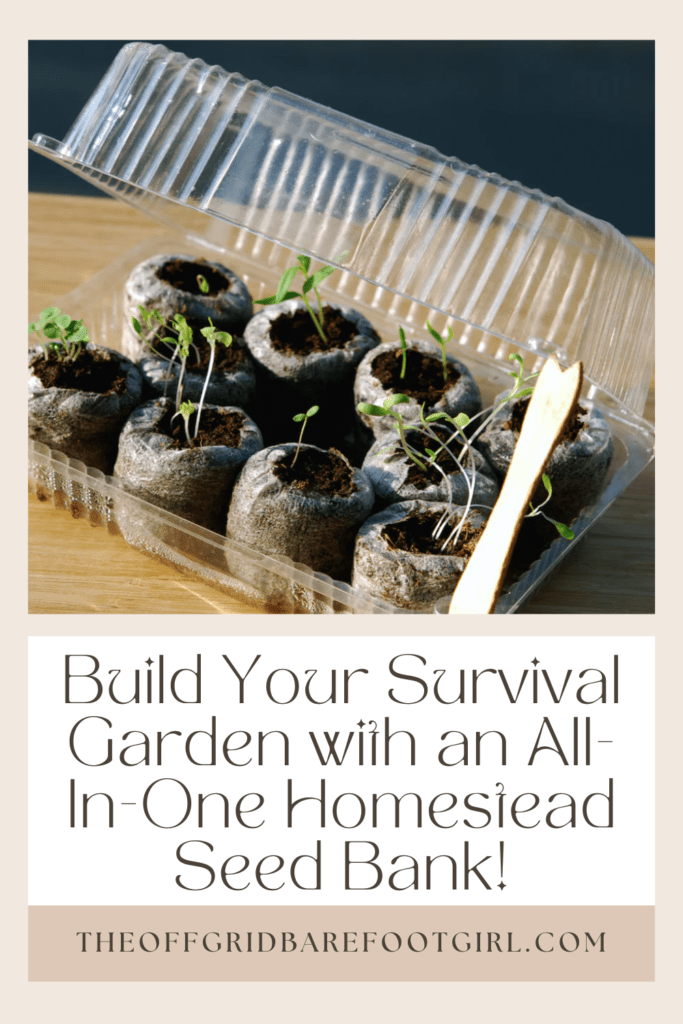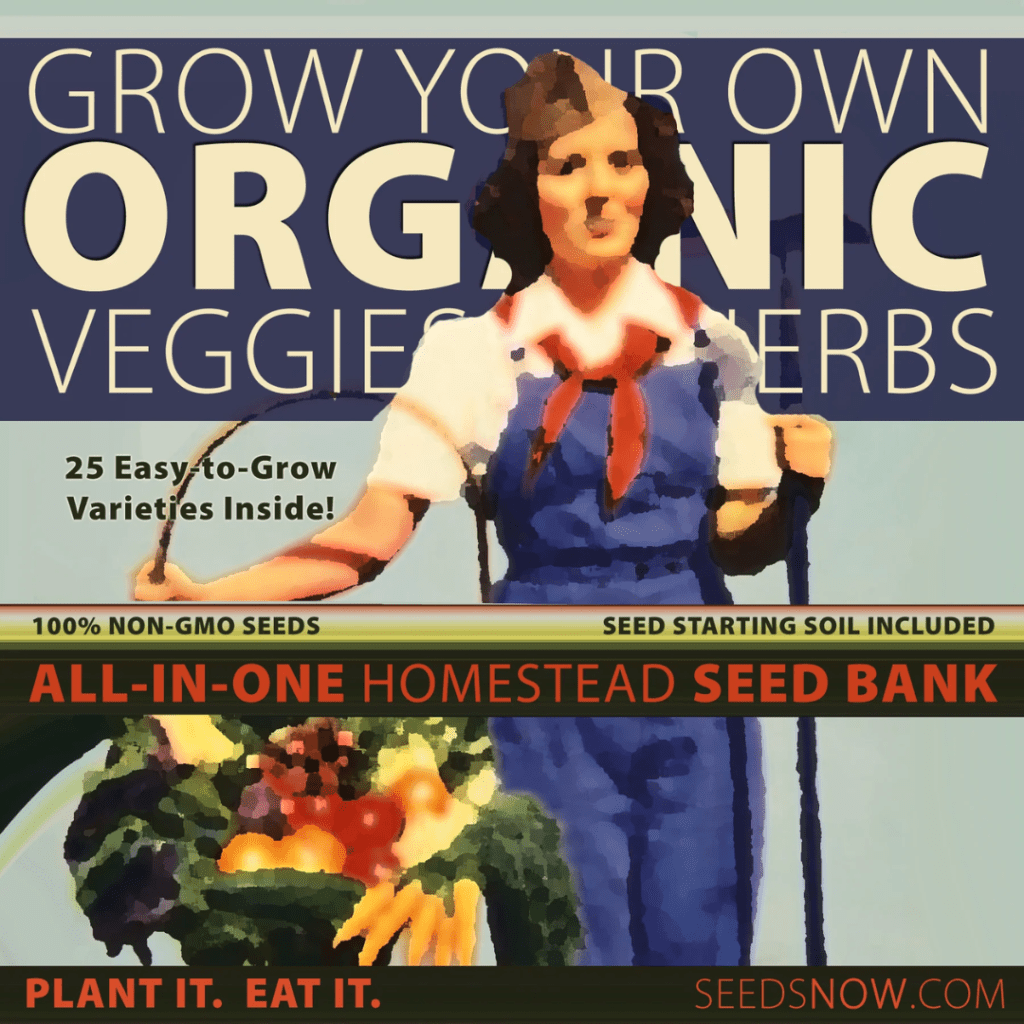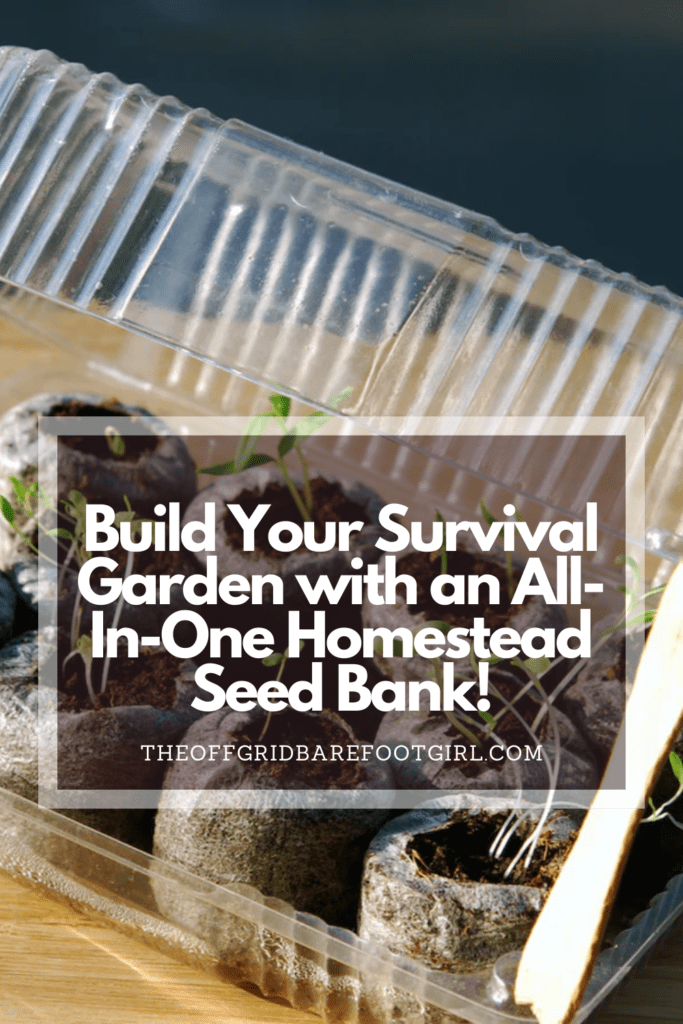Homestead seed bank.
What Is Included in This Post:
- Introduction to the All-In-One Homestead Seed Bank
- Benefits and Importance of Homestead Seed Banks
- Selecting the Right Seeds for Your Homestead
- Storing and Preserving Seeds for Long-Term Survival
- Tips for Successful Seed Starting and Germination
- Planning and Managing a Sustainable Homestead Garden
- Harvesting, Saving, and Replenishing Seeds for Future Use
- Conclusion
- Frequently Asked Questions
- Get Your Homestead Seed Bank Now!
As individuals and communities increasingly seek self-sustainability and resilience, the concept of homesteading has gained considerable popularity. A crucial aspect of successful homesteading is the ability to grow and maintain a diverse range of crops to ensure long-term food security. This is where the All-In-One Homestead Seed Bank comes into play. In this article, I will explore the benefits and importance of homestead seed banks, discuss how to select the right seeds for your specific needs, learn about proper seed storage and preservation techniques, and gather valuable tips for successful seed starting and garden management. By the end, you’ll be well-equipped to establish and maintain your own self-sustaining homestead garden.
This is a pinnable post. Tap or hover over any image in this post to pin to your Pinterest Boards.

Introduction to the All-In-One Homestead Seed Bank

Welcome to the world of homestead seed banks, where self-sufficiency meets horticultural prowess! In this article, I will dive into the concept of homestead seed banks and explore the benefits of having an all-in-one seed bank at your fingertips.
Have you ever thought about growing your own homestead garden? It’s a fantastic way to reconnect with nature and get in touch with your food source. Imagine being able to step into your backyard and pluck fresh vegetables or herbs to use straight away in your cooking – it’s an incredibly rewarding feeling. Plus, you’ll have complete control over what goes into your produce, ensuring that it’s free from harmful chemicals or pesticides. Not to mention, gardening is a fantastic form of exercise and stress relief. It allows you to unwind after a long day while getting some vitamin D from the sun.
Whether you’re a seasoned gardener looking for a new challenge or just starting out, a homestead garden can provide countless benefits both for your physical health and mental well-being. Give it a shot – it might just become one of the most satisfying hobbies you’ll ever have!
However, getting started can quickly become overwhelming when selecting your seeds. To make this process easier, you can purchase your homestead seed bank that includes all the vegetables you need to grow a great homestead garden!
SeedsNow offers an inclusive homestead seed bank to get your homestead garden off to a great start to sustainability.
What’s Included:
- 25 seed varieties!
- Individually packaged and labeled in resealable bags!
- Mylar bag packaging with zip-lock enclosure for long-term storage!
- 25 seed starting soil pods!
Understanding the Concept of Homestead Seed Banks
Homestead seed banks are like treasure troves for the self-sufficient gardener. They are a collection of seeds carefully curated to provide a wide variety of vegetables, herbs, and fruits for your homestead. These seeds are typically open-pollinated or heirloom varieties, which means you can save the seeds from your crops and replant them year after year. It’s the circle of life, plant edition!
The Advantages of Having an All-In-One Seed Bank
Now, why should you invest in an all-in-one seed bank? Well, picture this: you’re planning your garden for the upcoming season, and you realize you need to order seeds from multiple sources to get everything you want. But with an all-in-one seed bank, you have a diverse selection of seeds in one convenient package. Plus, it saves you time, money, and the headache of juggling different seed orders.
Benefits and Importance of Homestead Seed Banks
Homestead seed banks are more than just a fancy gardening accessory. They play a crucial role in ensuring long-term food security and promoting self-sustainability.
I love purchasing seed banks and vaults for my homestead. I have written a separate post that goes into details about purchasing seed vaults for your garden and pantry supply to help you maintain a good seed bank or vault for years of seeds to grow anything you want! Be sure to check out that post too!
Best Survival Seed Vaults to Stockpile for a Crisis
Ensuring Long-Term Food Security
In a world of uncertainty, having a stash of diverse seeds means you have the power to grow your own food, even in challenging times. Whether it’s a sudden disruption in the food supply chain or a zombie apocalypse (hey, you never know!), a homestead seed bank can be your secret weapon for feeding yourself and your loved ones.
Promoting Self-Sustainability and Self-Reliance
By growing your own food, you become less reliant on grocery stores and industrial agriculture. You can cultivate a sense of self-sufficiency and take pride in knowing that you are responsible for putting delicious, nutritious meals on the table. Plus, who doesn’t love the satisfaction of enjoying a salad made from veggies you grew with your own green thumbs?
Preserving Heirloom and Rare Plant Varieties
Homestead seed banks are like seed libraries, preserving the genetic diversity of plant species. By growing and saving seeds from heirloom and rare plant varieties, you contribute to the preservation of traditional crops that might otherwise disappear.
Selecting the Right Seeds for Your Homestead
When it comes to selecting seeds for your homestead, it’s essential to choose wisely. Here are some factors to consider:
Identifying Suitable Crops for Your Region and Climate
You don’t want to grow oranges or bananas in the Arctic! Research which crops thrive in your specific region and climate. This way, you’ll ensure that your efforts yield happy, healthy plants that actually produce food (and not just strange looks from your neighbors).
Considering Dietary Needs and Preferences
Do you have dietary requirements or preferences? Maybe you’re a diabetic and need to avoid starchy high-carb potatoes, allergic to certain vegetables, or have a love-hate relationship with Brussels sprouts. Whatever the case, select seeds that align with your dietary needs and culinary desires.
Choosing Disease-Resistant and Resilient Plant Varieties
Gardening can be a battle against pests and diseases. Arm yourself with seeds of plant varieties known for their disease resistance and resilience. This way, you’ll have fewer plant casualties and more bragging rights when your garden thrives while others falter.
Storing and Preserving Seeds for Long-Term Survival
Congratulations! You’ve collected an impressive array of seeds for your homestead. Now, let’s make sure they stick around for the long haul.
Understanding Seed Viability and Longevity
Seeds, like everything in life, have a shelf life. Understanding seed viability and longevity will help you determine how long you can store them and still expect them to germinate successfully. Just remember, seeds are not immortal beings (unless they’re the magical kind from fairy tales, in which case please share!).
Properly Storing Seeds for Optimal Conditions
To keep your seeds happy and healthy, they need the right storage conditions. Generally, seeds prefer cool, dry, and dark environments. So, avoid storing them in your sauna, the bathroom cupboard with a leaky pipe, or your Aunt Mildred’s creepy basement (trust me, it’s a bad idea).
Using Appropriate Packaging and Labeling Techniques
Lastly, proper packaging and labeling are crucial for keeping your seeds organized and ensuring you don’t mistake a tomato seed for a cucumber seed (awkward!). Invest in seed envelopes, jars, or other suitable containers, and don’t forget to label them clearly. Bonus points if your labels are legible and don’t resemble hieroglyphics!
Tips for Successful Seed Starting and Germination
Providing Ideal Conditions for Seed Starting
To give your seeds the best chance of success, make sure they have the ideal conditions for germination. This includes providing them with a warm and moist environment. You can create a mini greenhouse effect by placing seed trays in a covered container or using a seed starting kit with a plastic cover. Additionally, ensure that the soil is well-drained and prepared to provide the necessary nutrients for growth.
Understanding Germination Requirements for Different Plants
Different plants have different germination requirements, so it’s important to understand the specific needs of the seeds you are planting. Some seeds may require soaking before planting, while others might need a period of cold stratification. Research the germination requirements of each plant variety and follow the instructions accordingly to maximize your success rate.
Common Challenges and Troubleshooting Techniques
Seed starting can come with its fair share of challenges. One common issue is damping off, which is when seedlings become weak and collapse due to fungal diseases. To prevent this, ensure proper air circulation and avoid overwatering. Another challenge is leggy seedlings, which are tall and weak due to lack of light. Place seed trays in a well-lit area or use grow lights to provide adequate light for strong growth. Monitoring for pests and diseases is also crucial in troubleshooting seed starting issues.
Planning and Managing a Sustainable Homestead Garden
Mapping Out Your Homestead Garden Space
Before starting your homestead garden, it’s essential to map out your garden space. Consider factors like sunlight exposure, soil quality, and proximity to water sources. Plan your garden layout, taking into account the space each plant requires and the optimal placement for companion planting.
Implementing Permaculture and Companion Planting Techniques
Permaculture and companion planting are sustainable gardening practices that maximize the efficiency and health of your garden. Permaculture involves designing your garden in a way that mimics natural ecosystems, promoting biodiversity and reducing waste. Companion planting involves strategically planting complementary plants that can help repel pests, attract beneficial insects, and enhance nutrient absorption.
Practicing Organic and Sustainable Gardening Methods
On a homestead, it’s important to prioritize organic and sustainable gardening methods to minimize environmental impact and promote the long-term health of both your family and the ecosystem. This includes avoiding chemical pesticides and fertilizers, using organic and natural alternatives, practicing crop rotation, and incorporating composting and mulching techniques.
Harvesting, Saving, and Replenishing Seeds for Future Use
Knowing When and How to Harvest Seeds
Harvesting seeds at the right time is crucial for their success. Wait until the plant has fully matured and the seeds have ripened. Different plants have different indicators, such as dried seed pods or brown and crispy fruit. Once harvested, remove any excess plant material and separate the seeds.
Properly Cleaning and Drying Seeds for Storage
To ensure the longevity of your seeds, it’s important to properly clean and dry them before storage. Remove any debris or chaff by gently shaking or blowing on the seeds. Alternately, remove any slimy flesh residue from the seeds with a quick soak in water and pat them dry. Then, spread them out in a well-ventilated area away from direct sunlight to dry completely. Once dry, store them in airtight containers or envelopes in a cool and dark place.
Developing a Seed-Saving Strategy for Continuous Supply
To maintain a continuous supply of seeds for your homestead, develop a seed-saving strategy. Consider factors like crop rotation, isolation techniques to prevent cross-pollination, and maintaining genetic diversity by saving seeds from multiple plants. Keep detailed records of the seeds you save, including variety, date, and any relevant notes, to help you organize and plan for future seasons. I like to plant a few extra plants of each plant that I am growing for strictly seed saving.
Conclusion
In conclusion, the All-In-One Homestead Seed Bank offers a comprehensive solution for those seeking self-sustainability and long-term food security. By carefully selecting, storing, and preserving seeds, and implementing successful seed starting and garden management techniques, you can establish a thriving homestead garden that provides for your needs and ensures a continuous supply of seeds for the future. Embracing the concept of homesteading and utilizing a well-maintained seed bank empowers individuals and communities to take control of their food sources and foster a more sustainable future. Start your journey towards self-reliance and resilience by establishing your own All-In-One Homestead Seed Bank today!

Frequently Asked Questions
1. What is a homestead seed bank?
A homestead seed bank is a collection of carefully selected and preserved seeds that are specifically chosen for a homestead garden. It serves as a reliable source of seeds for long-term food security and self-sustainability.
2. Why is it important to have a homestead seed bank?
A homestead seed bank is important because it ensures a continuous supply of seeds for future planting. It allows homesteaders to preserve heirloom and rare plant varieties, adapt to changing climates, and maintain self-sufficiency by producing their own food.
3. How do I select the right seeds for my homestead?
Selecting the right seeds for your homestead involves considering factors such as your region’s climate, dietary preferences, and the specific needs of your homestead. Researching suitable crops for your area and choosing disease-resistant and resilient plant varieties can help guide your seed selection process.
4. How do I store and preserve seeds for long-term survival?
Proper storage and preservation techniques are crucial for maintaining seed viability. Seeds should be stored in a cool, dark, and dry environment, preferably in airtight containers or packaging. Additionally, labeling the seeds with relevant information and periodically checking their viability can help ensure their long-term survival.
Summary
I hope I have inspired you to start your homestead seed bank with these tips and products.
If you were encouraged by this post, I invite you to check out my FREE Printables Page for fun free printables, planners, and charts.
ENTER MY FREE Printables Page HERE
Here are some more of my composting and gardening inspiration posts to check out!
Easiest Heirloom Vegetable Seeds to Grow Now
How to Use the Hand Twist Claw Tiller: Tackling Tough Soil
Planning Your Garden: How to Plan a Vegetable Garden: Expert Green Thumb Tips!
Winterizing the Garden: How to Winterize Your Vegetable Garden: Step-by-Step Checklist
Mulching the Garden: How to Make Leaf Litter Mulch
Grow a Pumpkin Patch: How to Grow a Pumpkin Patch in Your Backyard
How to Win a Giant Pumpkin Contest
How to Grow a Fall Garden: 9 Best Fall Crops
Clever Ways to Incorporate Indoor Composting into Your Home
How to Start Composting for the Garden: A Step-by-Step Guide
The Ultimate Guide to Composting in Your Suburban Backyard
Why I Built A Survival Garden in My Backyard
How to Grow A Foodscape Garden From Scratch
16 Best Medicinal Herbs to Grow in Your Garden Now
Blessings,
The Off Grid Barefoot Girl




